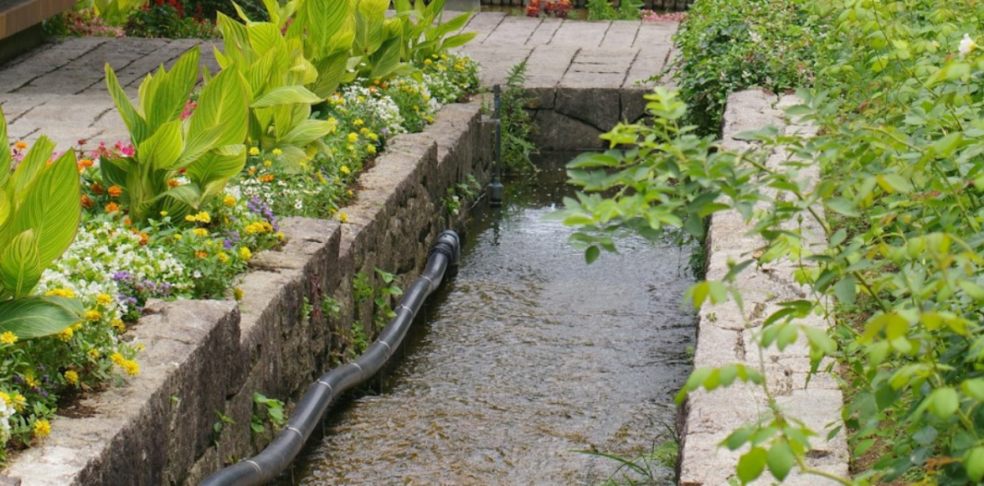
How to Build a Rain Garden to Manage Water Runoff
In today’s paved-over world, rain rarely gets the chance to sink into the soil.
More often, it hurries over roofs, driveways, and concrete paths, dragging oil, dirt, and debris along the way before vanishing into overloaded drains. It’s a messy, typically unnoticed problem until the water starts pooling where it shouldn’t.
That’s where rain gardens step in. Elegant yet unassuming, they’re built to capture stormwater and clean it up naturally, without fuss.
They quietly enhance the curb appeal of your home, promote local wildlife, and cool the air. Just ingenious design and native plants doing their part—neither pipes nor pumps.
How Rain Gardens Actually Work
Rain gardens aren’t just pretty patches of green. They’ve got a job to do. When rain hits, they drink it in, drawing water down through clever layers of soil that quietly clean as they go.
The plants are part of the plan too—roots twisting through the earth, creating hidden passageways that pull water deep below.
Instead of rushing off into gutters, the rain disappears underground, leaving behind clear streams and streets that don’t turn into lakes.
Why Rain Gardens Are Eco Powerhouses
Rain gardens serve as miniature green infrastructures that restore the ecological balance often lost in urban developments.
Their design supports a layered ecosystem where soil organisms, native flora, and small wildlife interact to improve the health of the surrounding environment.
One of the less obvious but equally important benefits is soil regeneration. In the long run, rain gardens improve the soil where they are planted by promoting deep root growth and natural composting through leaf litter and mulch.
This enriched soil, in turn, fosters healthier plant life and increases the garden’s resilience to pests and disease.
Additionally, they subtly contribute to better air quality. Dense vegetation—especially native plants that prefer moisture—traps airborne particulates and lowers dust levels in and around the property.
In cities, this can really help households dealing with breathing issues.
On a smaller climate scale, rain gardens quietly balance heat and moisture. Thanks to leafy transpiration and cool, shaded soil, they can lower the temperature in tightly packed areas—offering a bit of genuine comfort when summer turns relentless.
Success Stories from Cities Around the World
Urban areas like London and Manchester have successfully introduced these gardens.
In London, they discreetly mitigate flood risks by absorbing excess rainfall. Manchester integrates them into parks, easing pressure on drainage systems while preserving natural surroundings.
These cases illustrate how rain gardens merge utility with aesthetics, turning sustainable water control into a harmonious landscape feature.
Beyond the UK, cities such as Portland (USA) and Malmö (Sweden) have embedded rain gardens into their long-term urban planning.
For instance, in Portland, you'll see rain gardens, sometimes called (bioswales), that border the roadways. This beautifies the area while also making it safer for drivers and reducing the amount of stormwater runoff.
Communities in Malmö have also shown that stormwater management and public pleasure can coexist with the installation of municipal rain gardens that also serve as recreational green areas.
From little gardens in individual houses to large-scale systems for whole cities, these examples from across the world demonstrate how versatile rain gardens can be.
Finding the Perfect Spot
Finding the appropriate location involves more than simply identifying the lowest spot in your garden.
Rainwater naturally collects in certain zones—beneath gutters, within shallow depressions—making them ideal candidates.
Such areas act as organic catchment points, but gradient is crucial. A gentle slope, ideally not exceeding five degrees, ensures steady water flow without promoting erosion.
Accordingly, steer clear of septic systems and underground pipes to avoid future issues.
Performing a quick drainage test can prevent complications. Dig a small hole, fill it with water, and observe. If it drains at a consistent rate, the site is suitable. If it stagnates, reconsider.
A rain garden should also offer aesthetic value. Situate it where it’s visible—perhaps from a patio or through a living room window. When placed thoughtfully, utility and beauty blend seamlessly.
Selecting the Ideal Native Plants
A successful rain garden starts with carefully selecting the right plants.
Native species are the ideal starting point, as they’re already well-suited to the local climate and soil, requiring very little maintenance.
Perennials provide structure and help prevent erosion, while shrubs create nesting spaces for birds and insects. Ornamental grasses add both texture and movement, along with a natural ability to manage moisture.
In the UK, foolproof selections include Marsh Marigold, Purple Loosestrife, and Meadowsweet. These species cope well with wet conditions and bring seasonal beauty to any space.
It’s also important to consider the arrangement. Think of it like staging a quiet performance. The taller plants take their place at the back or centre, forming the backdrop.
The shorter ones step forward, catching the light and rain without being overshadowed. Everyone gets their moment, and the whole scene stays beautifully balanced.
Before planting, it’s wise to consult a local nursery or garden experts. Their guidance can help you make the right selections and avoid introducing anything invasive.
Sizing It Right
Accurate sizing boosts rain garden performance. First, figure out how much area is covered by inaccessible surfaces (patios, paths, and roofs) that absorb rainfall.
As a general guideline, allocate roughly one-third of the combined area to your rain garden. This provides a balanced solution for runoff without overburdening the system.
Depth is equally significant. A range between 15 and 30 centimetres is typically sufficient, though the type of soil you’re working with will determine the precise depth.
Sandy soils allow quick drainage, requiring less depth. Conversely, clay retains water longer and benefits from deeper excavation. A drainage test will clarify what’s appropriate.
Shape also plays a role. A shallow, bowl-like form helps spread water evenly, reducing surface runoff while maintaining structure.
To plan precisely, use stakes and string to outline the garden. These simple tools assist in achieving both practicality and symmetry.
Step-by-Step Installation
Begin by spreading a generous 5 to 7 centimetres of compost across the base of your rain garden.
This simple step does more than nourish—it improves drainage and helps capture pollutants before they seep into the water system.
Next, plan your planting like a composition. Group plants by both their height and water needs. Taller varieties should stand at the centre or towards the back, where they won’t overshadow their smaller companions.
Shorter species sit nicely along the edges, keeping the layout balanced while ensuring every plant receives sufficient sunlight and moisture.
Allow space between them. Although it can be appealing to fill every gap, overcrowding results in weakened growth and poor air circulation. Proper spacing gives your plants room to breathe and establish themselves.
Timing is just as important as placement.
Early spring and autumn are the golden windows—when the soil still holds warmth, rainfall is steady, and the scorching days of summer remain a distant threat. These conditions are just right for roots to settle in deeply and securely.
Keep up with regular watering, especially when the weather turns dry. A steady routine helps plants develop strong, deep roots that keep them anchored and healthy over time.
To finish, add a tidy layer of mulch around each plant. This gives your garden a polished look in addition to keeping the soil moist and weeds at bay.
Routine Care for Lasting Beauty
Maintaining a rain garden is less about effort and more about rhythm. After each significant rainfall, the landscape quietly reveals what needs attention.
The garden's contours can be changed to better direct water flow, reducing erosion and guaranteeing uniform absorption.
Weed control forms part of this ongoing care. Removing unwanted growth each month allows the native plants to flourish without competition. It also keeps the garden looking intentional rather than overgrown.
Pruning plays a quieter role but carries equal weight. Seasonal trimming, especially of damaged or faded stems, revitalises plant health and supports airflow through dense areas, reducing the chance of disease.
Then comes mulching. Replenishing the layer once a year maintains moisture, keeps weeds at bay, and enhances the garden’s visual structure. It’s a small ritual that reinforces the overall design.
Wildlife begins to appear over time—drawn by shelter, colour, and movement. In a manner that ornaments could never match, bees, butterflies, and songbirds blend in with the landscape.
Their presence transforms the garden into a partnership with nature, rather than a project.
Addressing Common Issues
Even well-planned gardens encounter setbacks. Persistent standing water can damage both plants and the soil’s integrity.
Reshape the garden into a shallow, concave basin to facilitate flow and dispersion.
Add some fine gravel or sand to improve permeability if the soil is too compacted. Reassess the area after varied weather events to confirm improvements.
When plants falter, it often signals environmental mismatch. That said, review your species selection and favour resilient natives that withstand wet-to-dry conditions.
If necessary, replant during spring or autumn to increase the likelihood of healthy establishment.
Staying ahead of weeds is vital. Regular mulching and hand-pulling offer the most environmentally sound solutions.
Moreover, manual removal limits disruption to nearby plant roots and avoids chemical interference. So, address weeds promptly to prevent them from overtaking the space.
Conclusion
With a bit of forethought—and expert guidance where it counts—homeowners can shape gardens that work with water, not against it.
These spaces don’t just handle rainfall; they bring charm to the landscape and breathe life back into tired plots.
A rain garden is more than a drainage fix. It’s a quiet revolution in how we manage our spaces—gentle on the earth, easy on the eyes, and kinder to future infrastructure.

















